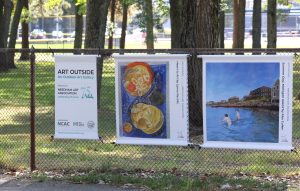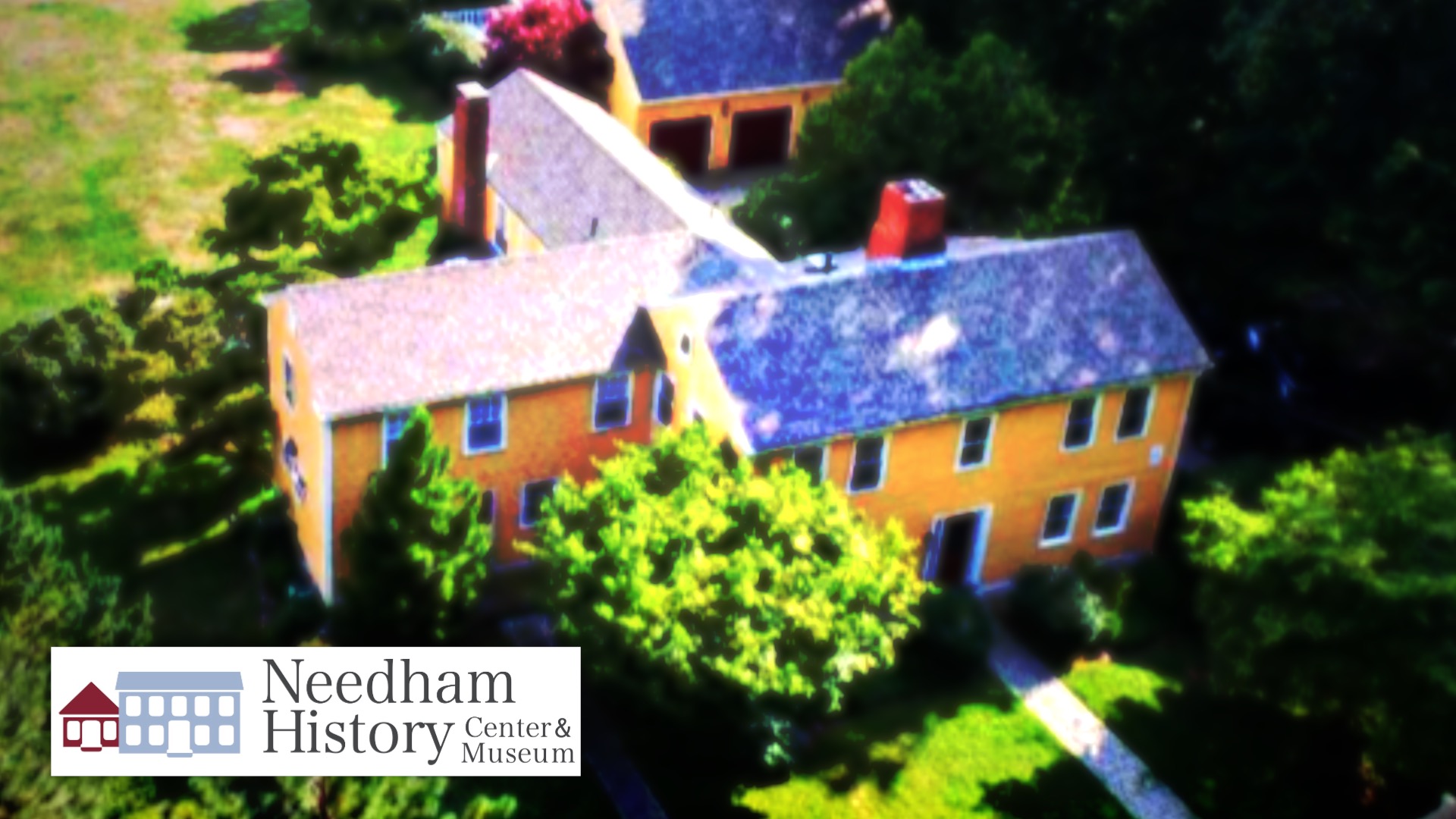
Needham History: So Much History! (Part 2)
River! That in silence windest
Through the meadows, bright and free…
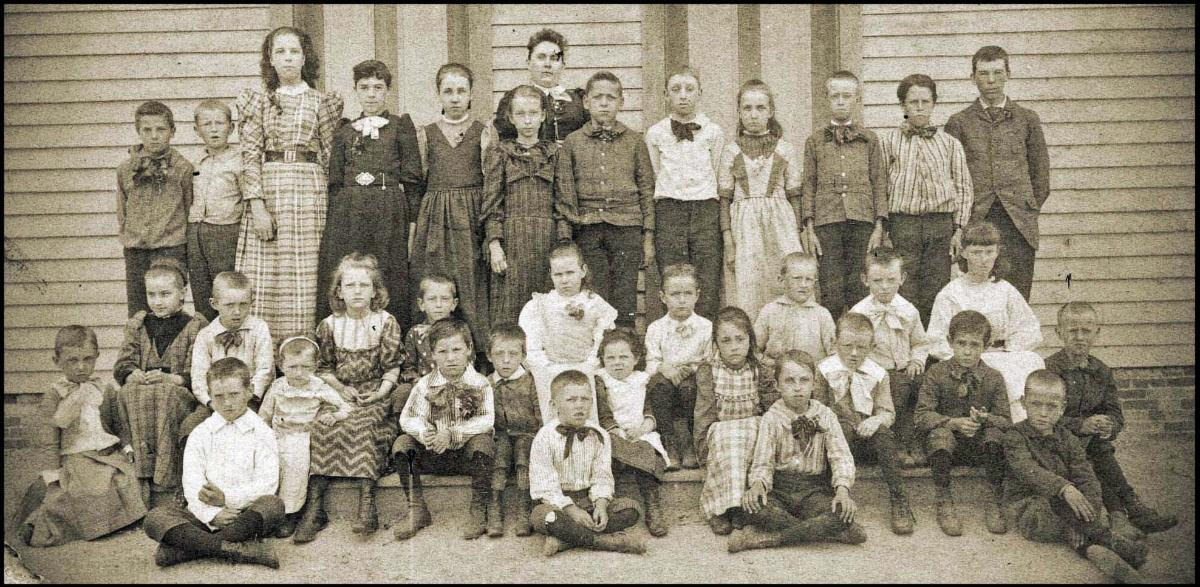 Students at the Harris School on Great Plain Avenue, in 1893. NC Wyeth, 10 years old, is in the back row (in the dark jacket, in front of teacher Mary Glancy). His brother Edwin is front and center, with crossed legs in the white shirt.
Students at the Harris School on Great Plain Avenue, in 1893. NC Wyeth, 10 years old, is in the back row (in the dark jacket, in front of teacher Mary Glancy). His brother Edwin is front and center, with crossed legs in the white shirt.
So Much History!
(Part 2)
River! That in silence windest
Through the meadows, bright and free,
Till at length thy rest thou findest
In the bosom of the sea!
–To the River Charles, Henry Wadsworth Longfellow
In our last episode… Landowner Joshua Lewis built his house in 1776. His headstrong daughter Nabby ran away with a seaman from the Azores, but eventually they all came back. Woodcarver David Livingstone lived there for a while, then (skip a few owners), it was sold to Denys Zirngiebel, Needham’s Pansy King, who build his greenhouses on the property and invented the Giant Swiss Pansy for us to plant every spring. Now to continue…
In 1880, Zirngiebel’s daughter Hattie married an old neighbor from Cambridge – Andrew Newell Wyeth, who owned a hay and feed business in Charlestown. Zirngiebel built a new house for the couple next door to his own, and the South Street property became an extended family compound. NC (Newell Convers; 1882-1945) was the oldest of Andrew and Hattie’s four boys. The boys helped in the greenhouses, rowed canoes on the river, and rode ponies along South Street. As an aside, it is said that Henry Wadsworth Longfellow, another neighbor from Cambridge days, was a periodic visitor to the house, and that his poem “To the River Charles” was written while sitting under a tree in the backyard. The stump of the very tree (a chestnut?) still stands on the riverbank.
Andrew wanted N.C. to become a farmer, but the boy, who had shown artistic talent at a young age, did not want to be a farmer – he wanted to study art. NC eventually left Needham to study with Howard Pyle in Wilmington, DE. Pyle was, at the time, the preeminent American illustrator. (For more about Wyeth’s career as an artist, see “Needham’s Most Famous Son.”)
Wyeth raised his family in Chadd’s Ford, PA. But he was always homesick for Needham, and Needham (often in the form of the Lewis House and his parents’ house) was a frequent image in his paintings, such as “The War Letter”, “Paul Revere’s Ride,” “Old Blind Pew,” and others. So, after about 20 years he decided to move back here. When he did, he bought the Joshua Lewis house. The house had passed into the possession of Denys Jr after his father’s death; Junior maintained both the house and the nursery business for a while. In 1921, NC Wyeth bought his grandfather’s house from his uncle, and moved in with his family. He sent the kids to the Harris School, the same school that he had attended as a child. But the family was very unhappy here, and his children were homesick for Pennsylvania. NC himself was distressed at the rapid suburbanization of Needham – the farmland being turned into houselots, and the old houses being torn down and replaced (if only he knew!) After three years, they sold the house and moved back to Chadd’s Ford to stay.
NC’s youngest brother, Stimson, remained in the house for another three years, when it was sold to Lester and Hilda Bottomley. Hilda Bottonley’s cousin was the author Thomas Wolfe, who was a frequent visitor to the house and Needham.
Robert Douglas Hunter, “Autumn from the Patio of the Joshua Lewis House” (1991). Many of Hunter’s landscapes from the 1980s and 90s are scenes from the South Street property and vicinity.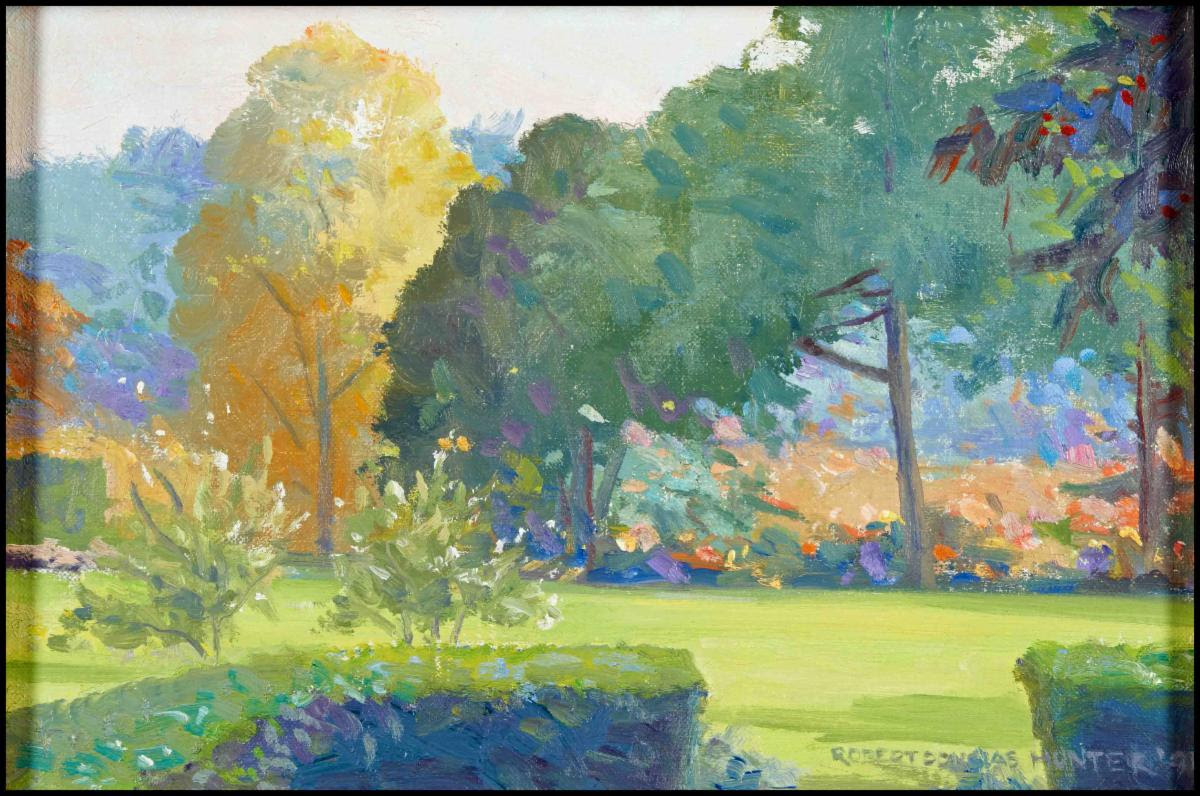
In the early 1980s a third artist bought the house – “Boston School” painter Robert Douglas Hunter (1928-2014). Hunter graduated from the Vesper School of Art in Boston in 1949, and also taught there for about 30 years, and at the Worcester Art Museum for another decade or so. The Boston School was inspired by Impressionism, but also incorporated more academic styles. The influence of Impressionism can be seen in Hunter’s landscapes, but he is best-known for his highly-realistic still lifes. Like Wyeth, Hunter was also inspired by the beauty of his South Street property, and many of his landscapes are views from his home along the Charles River, such as “Afternoon Light” (1991), “The Charles River, Needham-Wellesley,” “Autumn Landscape” (1987), and “Autumn from the Patio of the Joshua Lewis House” (1991). It is interesting to me that many of his landscapes show a strong affinity for Wyeth’s early landscapes of the same area.
During Hunter’s ownership, in 1982 the Joshua Lewis House was entered into the National Register of Historic Places. Its placement was based both on the architectural integrity of the house itself, and on the history enfolded within it: “The Joshua Lewis House possesses integrity of location, design, setting, materials and workmanship… [But] its major significance in local and national history derives from the people who have lived in it. The house has been associated with prominent local landowners of the eighteenth century, a noted wood-carver of the mid-nineteenth century, the innovative horticulturist Denys Zirngiebel and his friend Henry Wadsworth Longfellow, and finally the artist N.C. Wyeth. The Lewis House thus meets [the criteria] of the National Register of Historic Places.”
After about 20 years, Hunter sold the house to Nardin and Julia Baker. The Bakers were good stewards of their historic property, and delighted in making the house available for history house tours and school groups. When they were ready to downsize, the Bakers sold the house to Linda Bean to be part of the new NC Wyeth Research Foundation and Reading Libraries. The Wyeth Library (as known – the other name is too long) was founded to “engage the public in the life, art, and legacy of NC Wyeth.” It planned to incorporate several properties that were owned by Wyeth, including his summer home in Port Clyde, ME and the cottage in Wilmington, DE where he and his wife lived just after their marriage.
The Lewis house was a centerpiece of this plan – a long-time possession of Wyeth’s family, and the house where he grew up. It was also the largest and most conveniently-located of the various properties, and best suited for the Library’s plan to install the research collections of Douglas Allen. E. Douglas Allen, Jr, is an artist from New Jersey. His own work was inspired by Wyeth, and for most of his life he collected documents – manuscripts and letters, published books and articles, and ephemera – about NC Wyeth and his family. It is the most comprehensive collection of Wyeth documentation in existence. The plan was to install the Douglas collection in the South Street house and make it available for scholars and researchers.
Unfortunately, time ran out on this project when Linda Bean passed away unexpectedly in March. Work had progressed on making the house accessible to the public, but the organizational arrangements were not yet complete. The Foundation decided that their best course was to sell the Lewis House and use the proceeds to support their work in the Maine and Delaware properties.
This makes me sad for so many reasons. The Wyeth Library would have been a huge asset, not just for research but also for Needham. As an advisor to the project, I could foresee all sorts of programs for the schools and town based at the Library, and extensive partnership projects with the Needham History Center. Also, as part of the Wyeth Research Foundation, the historic and precious Joshua Lewis House would have been safe from the prospect of tear-down.
The Foundation is hoping for a buyer who will live in the house and care for it as its previous owners have done. In the meantime, I wait and worry. Be still, my beating heart.
A recent aerial (drone) view of the Lewis House and grounds. The front block is the oldest part of the house, and the wings to the back are additions made over the years. The grounds slope down to the Charles River. Longfellow’s tree stump is visible at the rear left.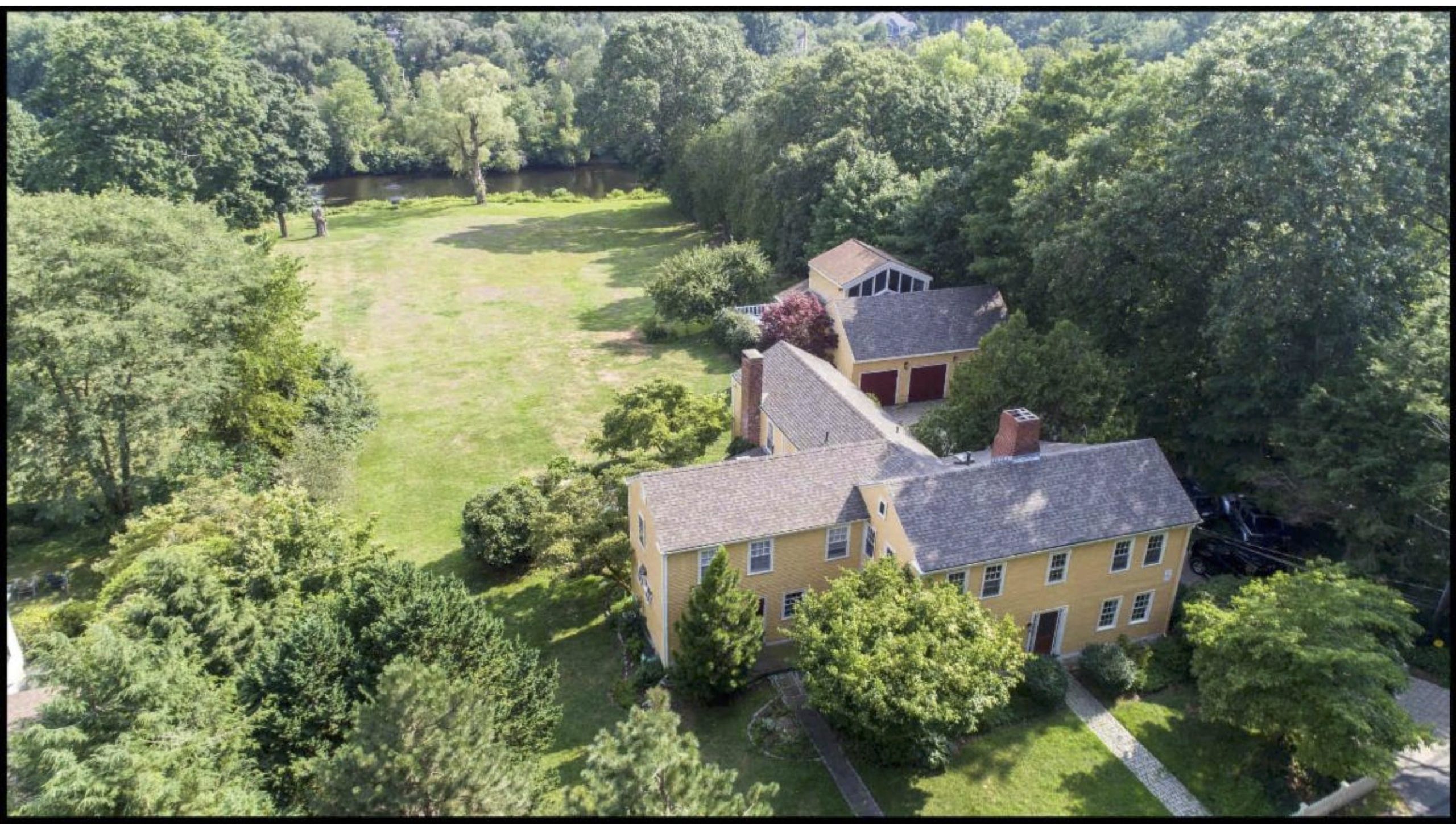
 |
Gloria Polizzotti Greis is the Executive Director of the Needham History Center & Museum. For more information, please see their website at www.needhamhistory.org. |
